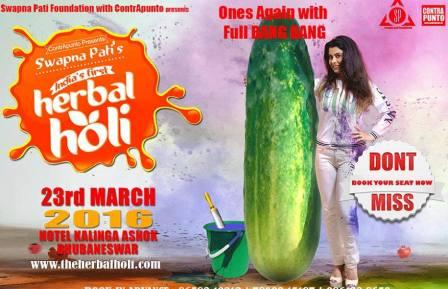Odisha Sun Times Bureau
Bhubaneswar, Mar 22:
Chemical colours cause more harm than we can imagine to our skin and to the environment. To fight this menace herbal holi is slowly becoming the in- thing to celebrate the festival of colours where natural colours like vegetables, fruits and flowers are used in place of dry and wet chemical colours.

Playing with herbal colours should not be a style statement but the need of the hour. Some may want to know how and from where to get these colours? The answer is simple, take a peek inside the kitchen and sweep a glance outside your garden. The answers are in front of your eyes- our own precious Mother Nature.
Swapna Pati Foundation along with Contrapunto Agency has been promoting the herbal holi in the capital city of Odisha for the last four years and it is also the first of its kind in the country.
This year the herbal holi will be celebrated on March 23 at hotel Kalinga .The colours will be made from different eco- friendly natural products like beetroots, tomatoes, neem leaves, pudina (mint), turmeric powder, sandalwood powder, multani mitti ( fuller’s earth), flour .

This trend started in a small way but has gained popularity after people who really cared about the environment joined hands to create awareness about the menace that is occurring with the use of chemical colours.
Holi can be played with home- made herbal colours that can be procured from nature:
Green- Sun dried henna leaves are finely ground and mixed with flour to make a fresh green colour. This is mixed with water to give out a lovely orange colour when applied to the skin and is totally safe. For wet colors spinach, palak, coriander and mint can be ground into a paste and added to water.

Brown- ‘Kattha’ or catechu extracted from the acacia tree can be mixed with water to get a brownish shade. Tea and coffee can be boiled in water to get a dark brown shade.
Magenta -The beetroot is sliced or grated and soaked in a litre of water and can be boiled to bring out the dark magenta shade.
Black -Dried Amla soaked overnight and boiled in an iron pot will give the desired black colour.
Yellowish- orange: To get the lovely yellowish-orange colour the Palash or Tesu flowers can be boiled and strained.
Red: The red sandalwood powder can be mixed with dried red hibiscus, dried red rose petals to give the lush red shade.

Yellow- Besan mixed with finely ground turmeric gives a lovely fresh yellow hue. Flowers like marigold, chrysanthemums, amaltas, sunflower etc. can be dried in the shade and finely ground to make a lovely yellow colour which can be used as both dry and wet colours.
Blue – Dried jacaranda flowers, blue hibiscus can be crushed and mixed with water or flour to give a peacock blue colour. Look beautiful and play herbal holi, also be the change that is so necessary for an eco-friendly holi celebration .



Comments are closed.